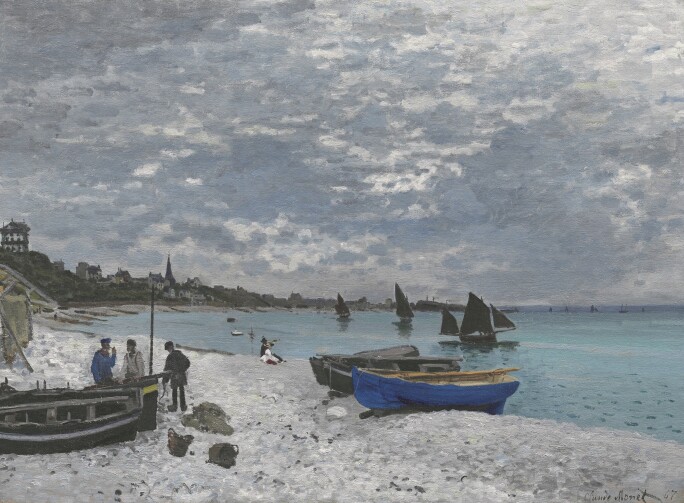
Boudin was one of the first to advocate painting in the open air as opposed to sketching outside and producing a finished composition in the studio. The present seascape is a superb example of the atmospheric effects he was able to capture: the startling white of the lighthouse in the background drawing out the highlights on the crests of the waves and headdresses of the local Breton women on the pier; In contrast, he uses unexpectedly restrained tones for the sails of the boats so that only the fluttering pennant catches the viewer’s eye in the right half of the composition.
Saint-Brieuc, bords du Légué is typical of Boudin’s oeuvre in replacing a central subject with small figures under a bright sky. Because his father was a mariner in the region, Boudin developed an appreciation for the changing light of the northern coast from an early age. Corot used to refer to these renditions as “meteorological beauties” and dubbed Boudin “King of the Skies.” The loose and sketchy feel of his paintings was quickly taken up by the younger group of artists who came to be known as Impressionists.

Monet met Boudin at just 18 years old, when the two happened to be introduced at the Gravier stationery shop in Le Havre. A fledgling artist known for his incisive caricatures, Monet spent much of that year painting alongside Boudin, absorbing the more experienced artist’s practice of painting from life. Works such as The Beach at Sainte-Adresse feature the low horizon line, dappled skies and dedication to naturalism that Boudin pioneered, while also hinting at the looser, more gestural style Monet would eventually develop. “Suddenly it was as if a veil had been torn from my eyes,” Monet wrote of Boudin’s work, “I understood what painting could be. Boudin’s absorption in his work, and his independence, were enough to decide the entire future and development of my painting” (quoted in Peter C. Sutton, Boudin: Impressionist Marine Paintings (exhibition catalogue), Peabody Museum of Salem, Massachusetts, 1991, p. 54).
The present work is offered by the Virginia Museum of Fine Arts in order to benefit future acquisitions.
